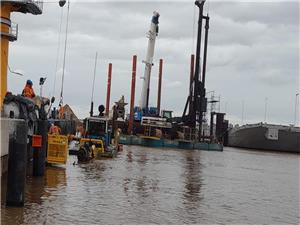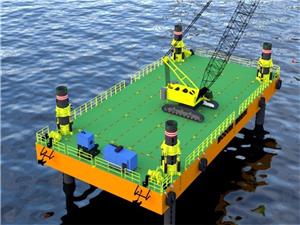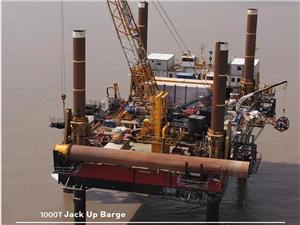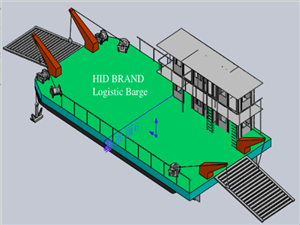Several Ways to Improve CSD Dredge Production
The production of a CSD greatly influences the profitability of a dredging project and in the end the profitability of your company. Due to the expensive operating cost of a CSD, a slight increase in production will already result in considerable profit gains.
However, we found that in many situations the CSD was not being operated till the full capability. This means more production can be attained and usually at the same cost.
The reason that the CSD is not used to the fullest is usually a lack of knowledge of the operator combined with a fear of trying things out of the ordinary. If the operator is not aware of the possibilities and methods to increase production, then it is almost certain that the production has room for improvement.
In this document, we are going to change that. We are providing you with some easy ways to increase production. These methods can be executed without large modification costs and most of them can be executed right from the start. These methods are not completely new, they have been around for a long time. I also hope that some or all of them are familiar to you, but ask yourself “Are we really doing that?” If the answer is no, then that is where you start.

Find the bottleneck in the system and identify surplus capacity
If you can identify the bottlenecks that are slowing down your dredge, you can increase productivity. In dredging, there is always one part of the process that is the slowest, and it may change as the dredge progresses. These bottlenecks continuously slow the dredge down. Identifying these bottlenecks will result in major performance improvements.
Use control systems
By using automation, contractors can massively increase productivity and improve the quality of life for their operators. Unlike a human operator, control systems don’t get tired from physical exertion. Each and every dredge operation is carried out with the same machine-like precision for hours on end. Using control systems helps ensure that production targets are met every hour of the day and that required dredge levels are achieved.
Replace Teeth Regularly
Every operator is aware that teeth need to be replaced after some time. Due to the contact with the soil, the teeth wear. If not replaced the adapters and cutter head will start to wear, which is much more costly to repair.
But what is the best time to replace the teeth? The answer is that there are two options The first option is when they are completely worn. This means that the teeth are worn to the point where the adapter is almost showing. Remember, the teeth not only have to cut, they also protect the adapter and cutter head, so replace teeth before it is worn till the adapter.
Therefore you need to replace teeth before they are completely worn, just to keep them sharp. Indications of when to do this is when you see a decrease in production and/or swing speed. Replacing teeth obviously requires downtime, so you have to find a balance between replacing and continuing, specific for your project.
Don't Repair Impellers:
Impellers are one of the items that is worn the most, along with wear rings. To save costs some companies opt to repair the worn impellers, instead of buying new ones. They weld new steel on the blades and holes, sometimes with wear resist materials.
This looks like a cost saving strategy, but in fact this is costing a lot of money.
Impellers look like simple steel parts, but in fact they are carefully balanced to make sure that the centre of gravity is exactly in the middle of the axis. After welding of steel on the impeller it is very unlikely that the centre of gravity will still be in the axis centre.
If it is not, vibrations will occur when the impeller is rotating. And the impeller is rotating a lot, almost continuously, which means there are continuously vibrations in the pump shaft. These vibrations can lead to damage to the liquidine, bearing blocks and even gearboxes. When one of these items breaks down it is a very costly repair. Not only for the parts, but also due to the huge amount of downtime.
Another reason why welding impellers leads to higher costs is the following. The blades of an impeller are carefully designed to give the highest efficiency possible. This means that you get almost the same amount of hydraulic power out, than you put drive power in. When material is welded on the impellers the shape of the blades is almost always changed. This leads to lower pump efficiency. So for the same amount of production, you are burning more fuel. Obviously not a good thing.
Have Regular Planned Maintenance
For us regular means weekly. So every week have planned maintenance in the order of 12 hrs in one time, called repair days. Having this amount of regular planned maintenance seems to cost time at first glance, but in the long run it will save huge amounts of money and time.
A CSD is equipment that is run all the time. There are no breaks in the production cycle like with THSD that allow for maintenance. Everything is running basically 24/7. In addition the power loads and forces on a CSD are very variable, not ideal for most equipment to say the least.
All this results in a great necessity for maintenance. The best way to do that is to have planned maintenance periods for which preparations can be made. Spare parts can be stocked, suppliers can be arranged for that day, bunkering vessels can be arranged, etc. This allows for very efficient execution of repairs. It also prevents consequential damage.
Consequential damage is damage that occurs as a consequence of another breakdown not being repaired in a timely manner. A good example is the hydraulic oil system. If one of the gears inside a gearbox is damaged metal splinters can enter the hydraulic system. So at first the gear needs to be repaired and oil needs to be refreshed. If this is not done quickly the metal splinters might damage other gears in the gearbox, oil filters, oil pumps, hydraulic cylinders elsewhere, etc. All the damages to other equipment not directly related to the first damage is called consequential damage. So the sooner the repair is executed the more damage is prevented. As you can imagine the repairs for a whole gearbox are much more expensive than only for one gear. Also the amount of time needed is much higher.
Decrease Pump Revolutions
This might be one of the most controversial methods of production increase around. The idea of high pump revolutions leading to high productions is very stubborn. It also very counter intuitive, which is probably the reason why it is often misunderstood and such a stubborn issue. We have seen this going wrong on many occasions.
Let us start by stating this: "Higher pump revolutions will not automatically lead to higher productions!"
In fact often a higher pump revolutions will lead to a lower production. A pumping process is a complex process, with a lot of variables and interaction between pump, drive and pipeline.
Production through a pipeline is a combination of flow, the volume of mixture, and the density, the amount of soil in the mixture. The pump revolutions influence only the flow, not the production. So if only the flow is increased and nothing else, the density will automatically come down. This means same production, but higher fuel consumption and higher wear rates.
When the suction process is the limiting process, ie the vacuum is high, the problem is even worse. The velocity has a quadratic influence on the vacuum. And the more vacuum is used for velocity, the less is available to achieve density. A 10% increase in velocity will result in a 20% drop in achievable density. This means a drop of 10% in production.
As mentioned, the whole pumping process is complex, and cannot be covered in this report, but in short, slower is better.
You need to keep mixture velocity just above the critical velocity. Just above the velocity at which mixture starts to settle.
Reduce Discharge Resistance
Almost all CSD's are discharging through a pipeline. Almost everybody understands that the longer a pipeline is the lower the production is.
But in reality, this understanding is not always applied. Ask yourself, are you always thinking about how to reduce the resistance?
Reducing the resistance can be done in a few ways. The most obvious is the shortening of the pipeline. This means a more direct route to the reclamation area. It also means using the minimum amount of floating pipelines possible. It also means adjusting the shore connection point if so required.
Another often found problem is the amount of bends, Y-pieces and valves. All of these also add to the discharge resistance and should be eliminated as much as possible. This also goes for floating lines, try to keep them as straight as possible and if you need to make a bend, try to make it as smooth as possible. Smoother bends not only lead to lower resistance, they also reduce the wear on the bend and the pipes directly after it. Also limit the use of spreaders and restrictions at the end of the pipeline. If a high flow is the problem, refer to the previous chapter, reduce the pump revolutions.
And lastly make sure that the reclamation area is not building a fountain, but keeps the pipeline as low as possible. A unobstructed horizontal exit at a level just above the reclamation level gives the lowest resistance and the best production.
When you reduce the resistance you either increase the production, or lower the fuel consumption. Both are great results you can achieve.




